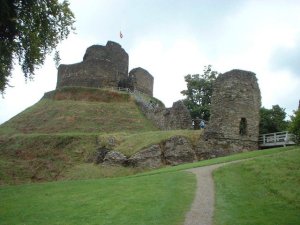
Launceston, PL15 7DR
Tel: (01566) 772365
Email: southwest@english-heritage.org.uk
Web: www.english-heritage.org.uk/visit/places/launceston-castle
Web: www.visitcornwall.com/things-to-do/history-and-heritage/launceston-castle
The original castle terrible
Launceston Castle was a status symbol, if ever there was one. The great Earls of Cornwall used it as the administrative headquarters of the vast estates they owned.
Known as Dunheved Castle it was originally a motte and bailey wooden castle. It was built by Robert, Count of Mortain in about 1066. The wooden keep was soon replaced by a stone circular shell keep. In 1227, stone walls and a tower were added by Henry III.
It was built, high on a grassy mound overlooking the town of Launceston, soon after the Norman conquest. The remains of the massive cylindrical keep, the high tower and the curtain walls still convey a sense of the vast power of these feudal lords.
They clearly rated safety above comfort. For despite the status lent by its strong defences, Launceston Castle never aspired to being a desirable residence. By contemporary standards, it was always rather cramped and inconvenient for a rich medieval baron.
When Edward's official surveyors visited the castle in 1337 and found it in a state of disrepair, repairs were made. Edward visited the castle again in 1353.
During the Civil War Launceston was known to be Royale et Loyale to King Charles I, hence its coat of arms. His son, the Prince of Wales , stayed in the town for a couple of days en route to the Royalist army based further down into Cornwall.
In 1643, however, the Parliamentarian forces under the command of Oliver Cromwell advanced in an attempt to capture Launceston, from the Royalists. The Royalist army stationed their forces on the summit of Windmill Hill, the steep hill which overlooks the town. The Parliamentarians captured the town, but were unable to dislodge the Royalist forces from Windmill Hill.
Sir Ralph Hopton, commander of the Royalist army, organised a cavalry charge down the hill, and despite fierce fighting, managed to force Cromwell's divisions back across the River Tamar. Launceston eventually fell to Cromwell in 1645.
The castle long remained a prison and George Fox, founder of the Quakers, suffered harsh confinement here in 1656.
As the venue for the county assizes and jail, the castle witnessed the trials and hangings of numerous criminals. The last execution was in 1821. A display at the castle traces 1,000 years of history, with finds from site excavations.
In 1838 the assizes and the seat of county government were moved from Launceston, to Bodmin. The jail, the last remaining building in the castle grounds, was demolished. The Duke of Northumberland had the castle landscaped and turned into a public park and garden. It remained as a park until being used by the US army in 1944 for a military hospital. In 1951 Launceston Castle was taken over by the Ministry of Works.
Launceston Castle features in the ceremony of the Dukes of Cornwall. In the 20th century, in their role as Dukes of Cornwall, both King George V and the Duke of Windsor visited the Castle in 1909 and 1921 respectively. King George VI, was already crowned when in 1937 he made a state entry into the Castle, being welcomed with age-old ceremonial and presented with feudal dues - a pound of pepper and one hundred shillings, which were set down in a charter of 1230 by Richard, Earl of Cornwall.
In 1973 Prince Charles was proclaimed Duke of Cornwall in Launceston Castle.
Launceston Castle is now managed by English Heritage.
Just a short walk from the town centre.
Opening Times22nd March - 31st October Facilities Admission Charged |
Cornwall's History Launceston
Pendennis Castle Restormel Castle St. Mawes Castle Tintagel Castle Trematon Castle English Heritage in Cornwall